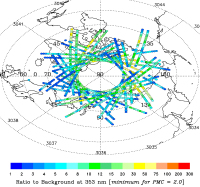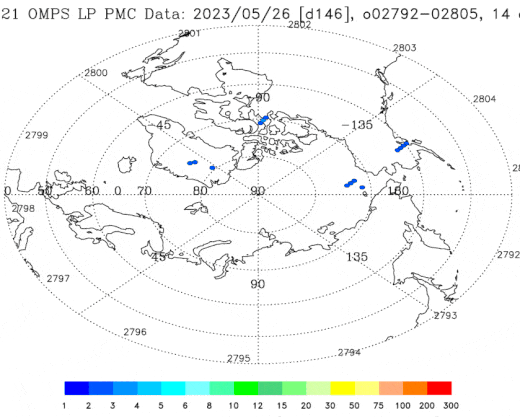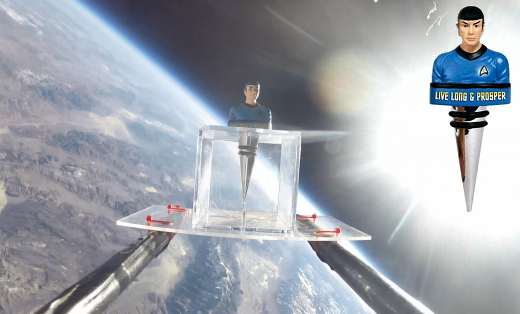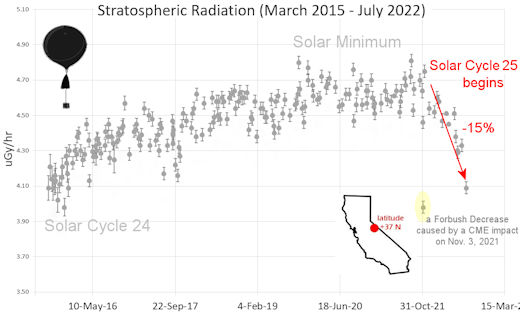 | | | Switch to: Europe, USA, New Zealand, Antarctica Credit: NOAA/Ovation  Planetary K-index Planetary K-index
Now: Kp= 1.00 quiet
24-hr max: Kp= 2.33 quiet
explanation | more data
Interplanetary Mag. Field
Btotal: 5.39 nT
Bz: -4.08 nT south
more data: ACE, DSCOVR
Updated: Today at 1146 UT  Coronal Holes: 13 Jun 23 Coronal Holes: 13 Jun 23 
Solar wind flowing from this small coronal hole could reach Earth on June 16th. Credit: SDO/AIA  Noctilucent Clouds Noctilucent Clouds
The northern season for NLCs began on May 26th. The first clouds were detected inside the Arctic Circle by the NOAA 21 satellite. An instrument onboard NOAA 21 (OMPS LP) is able to detect NLCs (also known as "polar mesospheric clouds" or PMCs). For the rest of the season, daily maps from NOAA 21 will be presented here:

Updated: June 12, 2023
Each dot is a detected cloud. As the season progresses, these dots will multiply in number and shift in hue from blue to red as the brightness of the clouds intensifies.
What happened to NASA's AIM spacecraft, which has been monitoring NLCs since 2007? Earlier this year, the spacecraft's battery failed. As a result AIM is offline, perhaps permanently. There may be some hope of a recovery as AIM's orbit precesses into full sunlight in 2024. Until then, we will maintain AIM's iconic "daily daisy," frozen at Feb. 28, 2023, as a show of thanks for years of service and hope for future daisies:  |  |  | Switch view:Ross Ice Shelf, Antarctic Peninsula, East Antarctica, Polar Updated Jun13  SPACE WEATHER
NOAA Forecasts | | Updated at: 2023 Jun 13 2200 UTC FLARE | 0-24 hr | 24-48 hr | CLASS M | 15 % | 15 % | CLASS X | 01 % | 01 % |  Geomagnetic Storms: Geomagnetic Storms:
Probabilities for significant disturbances in Earth's magnetic field are given for three activity levels: active, minor storm, severe storm Updated at: 2023 Jun 13 2200 UTC Mid-latitudes | 0-24 hr | 24-48 hr | ACTIVE | 10 % | 10 % | MINOR | 01 % | 01 % | SEVERE | 01 % | 01 % | High latitudes | 0-24 hr | 24-48 hr | ACTIVE | 15 % | 15 % | MINOR | 15 % | 15 % | SEVERE | 10 % | 10 % | | | |  | | | | | | | | | | | Text created by ChatGPT and other Large Language Models is spreading rapidly across the Internet. It's well-written, artificial, frequently inaccurate. If you find a mistake on Spaceweather.com, rest assured it was made by a real human being. This is an AI Free Zone! | | | QUIET TUESDAY: With every visible sunspot in decay, NOAA forecasters have lowered the chances of solar flares today to 15% for M-class flares and only 1% for X-flares. These numbers add up to a quiet Tuesday, June 13th. Solar flare alerts: SMS Text SPACE-BASED DETECTION OF NOCTILUCENT CLOUDS: Since NASA's AIM spacecraft stopped working earlier this year, sky watchers have been hoping for another spacecraft to help them track noctilucent clouds (NLCs). We've got it. The NOAA-21 satellite is now monitoring NLCs and reporting results to the general public. 
This animation shows the rapid spread of NLCs over the North Pole since the 2023 season started on May 26th. Each dot is a cloud detected by the OMPS Limb Profiler instrument onboard NOAA-21. As the season progresses, these dots will multiply in number and shift in hue from blue to red as the clouds thicken. NLCs are clouds of frosted meteor smoke. They form every year in summer when wisps of sunwarmed water vapor rise up to the edge of space. At altitudes greater than 80 km, the water crystallizes around disintegrated meteoroids, forming electric-blue structures visible in the night sky.
The original goal of OMPS was to make precision measurements of ozone, but it has proven useful for much more. Over time, the instrument's capabilities expanded to include smoke from wildfires and ash from volcanoes. Noctilucent clouds are its latest catch. In 2020, Matt DeLand and Nick Gorkavyi of Science Systems and Applications, Inc. published a paper showing how OMPS data nicely match NLCs imaged by NASA's AIM spacecraft: 
"OMPS LP stares backwards from the spacecraft at the atmospheric limb of the Earth," explains DeLand. "It measures light scattered by small ice crystals that make up the clouds." In the northern hemisphere, noctilucent cloud season runs from June to August. The clouds brighten and become most widespread usually around the summer solstice, with sightings in recent years as far south as Spain and southern California. Readers can track the progress of the clouds using daily maps from NOAA-21 right here on Spaceweather.com. Realtime Space Weather Photo Gallery
Free: Spaceweather.com Newsletter RARE MR. SPOCK WINE STOPPER: You can't buy this on Amazon--or anywhere else. Only the Earth to Sky Store has the rare Mr. Spock Wine Stopper. On Dec. 17, 2022, this handcrafted resin bottle stopper flew to the stratosphere onboard an Earth to Sky Calculus cosmic ray research balloon: 
You can have it for $170.10 (the serial number of the Enterprise divided by 10). This collector’s item comes with a gift card showing the stopper in flight and telling the story of its trip to the edge of space and back again. Far Out Gifts: Earth to Sky Store
All sales support hands-on STEM education
Realtime Aurora Photo Gallery
Free: Spaceweather.com Newsletter Every night, a network of NASA all-sky cameras scans the skies above the United States for meteoritic fireballs. Automated software maintained by NASA's Meteoroid Environment Office calculates their orbits, velocity, penetration depth in Earth's atmosphere and many other characteristics. Daily results are presented here on Spaceweather.com. On Jun 13, 2023, the network reported 6 fireballs.
(6 sporadics)  In this diagram of the inner solar system, all of the fireball orbits intersect at a single point--Earth. The orbits are color-coded by velocity, from slow (red) to fast (blue). [Larger image] [movies] Potentially Hazardous Asteroids ( PHAs) are space rocks larger than approximately 100m that can come closer to Earth than 0.05 AU. None of the known PHAs is on a collision course with our planet, although astronomers are finding new ones all the time. On June 13, 2023 there were 2335 potentially hazardous asteroids.
 | Recent & Upcoming Earth-asteroid encounters: | Asteroid | Date(UT) | Miss Distance | Velocity (km/s) | Diameter (m) | | 2023 LM | 2023-Jun-09 | 16.4 LD | 3.7 | 22 | | 2023 LS | 2023-Jun-09 | 0.2 LD | 4.5 | 4 | | 2023 LD | 2023-Jun-09 | 2.5 LD | 9.1 | 18 | | 2023 JB3 | 2023-Jun-09 | 14.1 LD | 6.9 | 52 | | 2023 LL | 2023-Jun-10 | 5.5 LD | 13.6 | 36 | | 2023 LA | 2023-Jun-12 | 1.7 LD | 10.4 | 31 | | 488453 | 2023-Jun-12 | 8.3 LD | 21.5 | 495 | | 2023 LQ | 2023-Jun-12 | 4.1 LD | 10.4 | 23 | | 2022 WN4 | 2023-Jun-13 | 10.8 LD | 15.1 | 158 | | 2023 LO | 2023-Jun-13 | 4.6 LD | 5 | 11 | | 2023 LZ | 2023-Jun-14 | 0.8 LD | 13.6 | 19 | | 2020 DB5 | 2023-Jun-15 | 11.3 LD | 9.5 | 506 | | 2023 HL | 2023-Jun-17 | 13.5 LD | 1 | 15 | | 2023 LV | 2023-Jun-18 | 11.9 LD | 8 | 36 | | 2023 LW | 2023-Jun-18 | 6.1 LD | 16.7 | 32 | | 2016 LK49 | 2023-Jun-19 | 17.4 LD | 19.4 | 22 | | 2023 HF1 | 2023-Jun-21 | 12.5 LD | 4.4 | 59 | | 467336 | 2023-Jun-24 | 17.4 LD | 7.1 | 269 | | 2008 LG2 | 2023-Jun-24 | 10.5 LD | 5.6 | 32 | | 2013 WV44 | 2023-Jun-28 | 9.1 LD | 11.8 | 95 | | 2022 MM1 | 2023-Jun-29 | 9.5 LD | 9.8 | 41 | | 2020 NC | 2023-Jul-02 | 13.9 LD | 7.7 | 123 | | 2023 HO6 | 2023-Jul-05 | 5.3 LD | 7.8 | 235 | | 2019 LH5 | 2023-Jul-07 | 14.9 LD | 21.6 | 281 | | 2018 NW | 2023-Jul-10 | 18 LD | 21.8 | 10 | | 2018 UY | 2023-Jul-12 | 7.4 LD | 16.4 | 243 | | 2020 UQ3 | 2023-Jul-18 | 3.2 LD | 9.3 | 59 | | 2022 GX2 | 2023-Jul-20 | 11.9 LD | 9.4 | 5 | | 2020 OM | 2023-Jul-20 | 8.5 LD | 9.5 | 14 | | 2015 MA54 | 2023-Jul-24 | 16.6 LD | 9.2 | 31 | | 2018 BG5 | 2023-Jul-27 | 10.7 LD | 8.4 | 56 | | 2020 PP1 | 2023-Jul-29 | 17 LD | 4.1 | 17 | | 2021 BD3 | 2023-Jul-30 | 14 LD | 8.5 | 25 | | 2016 AW65 | 2023-Jul-31 | 16.6 LD | 5.7 | 54 | | 2020 PN1 | 2023-Aug-03 | 10.8 LD | 4.8 | 29 | | 620082 | 2023-Aug-04 | 14 LD | 20.6 | 375 | | 2004 KG1 | 2023-Aug-06 | 18.7 LD | 9.2 | 54 | | 2022 BS2 | 2023-Aug-11 | 17.3 LD | 8.2 | 30 | Notes: LD means "Lunar Distance." 1 LD = 384,401 km, the distance between Earth and the Moon. 1 LD also equals 0.00256 AU. | | Cosmic Rays in the Atmosphere | SPACE WEATHER BALLOON DATA: Almost once a week, Spaceweather.com and the students of Earth to Sky Calculus fly space weather balloons to the stratosphere over California. These balloons are equipped with sensors that detect secondary cosmic rays, a form of radiation from space that can penetrate all the way down to Earth's surface. Our monitoring program has been underway without interruption for 7 years, resulting in a unique dataset of in situ atmospheric measurements. Latest results (July 2022): Atmospheric radiation is decreasing in 2022. Our latest measurements in July 2022 registered a 6-year low: 
What's going on? Ironically, the radiation drop is caused by increasing solar activity. Solar Cycle 25 has roared to life faster than forecasters expected. The sun's strengthening and increasingly tangled magnetic field repels cosmic rays from deep space. In addition, solar coronal mass ejections (CMEs) sweep aside cosmic rays, causing sharp reductions called "Forbush Decreases." The two effects blend together to bring daily radiation levels down. .Who cares? Cosmic rays are a surprisingly "down to Earth" form of space weather. They can alter the chemistry of the atmosphere, trigger lightning, and penetrate commercial airplanes. According to a study from the Harvard T.H. Chan school of public health, crews of aircraft have higher rates of cancer than the general population. The researchers listed cosmic rays, irregular sleep habits, and chemical contaminants as leading risk factors. A number of controversial studies (#1, #2, #3, #4) go even further, linking cosmic rays with cardiac arrhythmias and sudden cardiac death. Technical notes: The radiation sensors onboard our helium balloons detect X-rays and gamma-rays in the energy range 10 keV to 20 MeV. These energies span the range of medical X-ray machines and airport security scanners. Data points in the graph labeled "Stratospheric Radiation" correspond to the peak of the Regener-Pfotzer maximum, which lies about 67,000 feet above central California. When cosmic rays crash into Earth's atmosphere, they produce a spray of secondary particles that is most intense at the entrance to the stratosphere. Physicists Eric Regener and Georg Pfotzer discovered the maximum using balloons in the 1930s and it is what we are measuring today. | | The official U.S. government space weather bureau | | | The first place to look for information about sundogs, pillars, rainbows and related phenomena. | | | Researchers call it a "Hubble for the sun." SDO is the most advanced solar observatory ever. | | | 3D views of the sun from NASA's Solar and Terrestrial Relations Observatory | | | Realtime and archival images of the Sun from SOHO. | | | information about sunspots based on the latest NOAA/USAF Active Region Summary | | | current counts of failed and deployed Starlink satellites from Jonathan's Space Page | | | Authoritative predictions of space junk and satellite re-entries | | | from the NOAA Space Environment Center | | | fun to read, but should be taken with a grain of salt! Forecasts looking ahead more than a few days are often wrong. | | | from the NOAA Space Environment Center | | | the underlying science of space weather |  | Getting YouTube comments is essential if you want to beat the algorithm! That’s why you need to buy YouTube comments from RealSocialz.com because they offer real USA comments you can customize. |  | When looking for casinos to play online when the weather is bad, you can try casino online trucchi for Italian games. If you are not from Finland you can try the Swedish page Svenska casino online to find suitable games, check out svenskacasinoonline.net. Always check your local laws before playing with real money. |  | BestCSGOGambling is the best site for everything related to CSGO gambling on the web | | | These links help Spaceweather.com stay online. Thank you to our supporters! | | | | | | | | |  | |  |   | ©2021 Spaceweather.com. All rights reserved. This site is penned daily by Dr. Tony Phillips. | |

